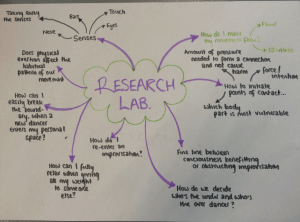Personally, I was nervous for this lesson. It wasn’t like a ‘normal’ contact improvisation lesson as we had never been able to lead parts of the class ourselves. This was all linked to our research labs which involved working in groups and coming up with questions around contact improvisation we would like to explore in more depth. When we were coming up with ideas last lesson I contributed the question ‘How can I fully relax, when giving all my weight to someone else?’ The background idea to this question relates a lot on my own practise. In lessons I find it hard to fully give my weight so by exploring that question it could help me in my own practise by applying some of the findings from our experiment.
After discussing the questions we all contributed we decided on two questions. Firstly ‘How much would the experience of contact improvisation change if you took away one of these senses? (hearing, vision, touch, smell) and secondly ‘how to initiate points of contact?’ After exploring these questions we came up with two different activities for the class to participate in. The first activity was having a few pairs in the space improvising with their eyes close. A few other pairs were watching them improvise and then the rest of the pairs had their back towards the space and could not see them improvise and after a while they swapped so everyone got a chance to experience each station of the activity. We made the task like this so everyone could get the chance to experience their vision taken away from them whilst dancing and also spectating. The task was to mainly focus on senses and consciousness and how if one of them was taken away how that would change you experience.
In the discussion after this activity we asked the class how they found improvising with their eyes shut and how it made them feel? We got mixed responses with some people saying it was uncomfortable because they were not sure on where about their partner was but then others said they enjoyed it as it made them to sway away from habitual movements. This activity relates to the quote ‘display to the public the bodies innate ability to respond physically to its environment’ (Lepkoff, 2008) This linked because it was the dancers job to respond with their bodies instead of their sight as their sight was taken away from them. When I trailed this activity the other day with my group it was an odd sensation as I wanted to create interesting shapes and balances but felt that was restricted because of the loss of my sight. However it felt more natural doing it, which again showed me how I should focus less on what I believe it looks like and focus more internally what it feels like. This relates to a quote in A Question by Daniel Lepkoff (2008) he states ‘rather than formulated within ones verbal mind is formulated and resides’. (Lepkoff, 2008) I found this quote relatable to my practise because you normally ask questions and answer them vocally but this is stating its possible to ask questions internally within the body and answer them through your actions. I believe through dancing with my partner with no sight we were forced to ask and answer questions through our actions together internally. This made me feel slightly more connected to my partner as we were focussing on what we were both feeling rather than what visually the contact looked like.
The second activity was slightly different and involved going into pairs. One person would stand there still and the other would create points of contacts on different parts of the body. For example tapping on different parts of the body. At the start of this activity a lot of the class were hesitant to give contact to their partner as they were lightly tapping on the other person and not giving very much meaningful contact. We then stated that vary the amount of pressure in each touch and try and find points of contact, which are more vulnerable than others. We then saw a difference in the force that they tapped their partner resulting in it looking more meaningful and direct. The second part was in partners experimenting with how much pressure you can give someone without them falling or collapsing because of your weight. This exercise was designed to see how much pressure you can apply on others when dancing. It was also to make people more aware to not be scared to apply pressure whilst improvising. In my practise personally I struggle to apply pressure as I am scared to place all my weight on someone else just in case they can’t take it. But by completing this exercise with my group before the lesson it made me realise how much weight I can give people without making them fall over which gave me confidence.
By doing these research labs, it has enabled me to create exercises with my group which has helped our research into finding answers to our questions. The research labs have been interesting to find the results of our questions and it was helpful to get so many opinions and different types of feedback from are peers.
I also found it enjoyable to take part in the other groups research labs as it was fun to see my peers lead parts of the class. Throughout the lesson I feel like as a class we all supported each other and gave commitment and enthusiasm throughout each activity that was thrown on us.
Ravn, S. (2010) Sensing weight in movement. Journal of dance and somatic practices, 2 (1) 21-34.
Brown, B. (1997) Is contact a small dance? Contact Quarterly: Contact improvisation sourcebook, 1(6) 72-75.
